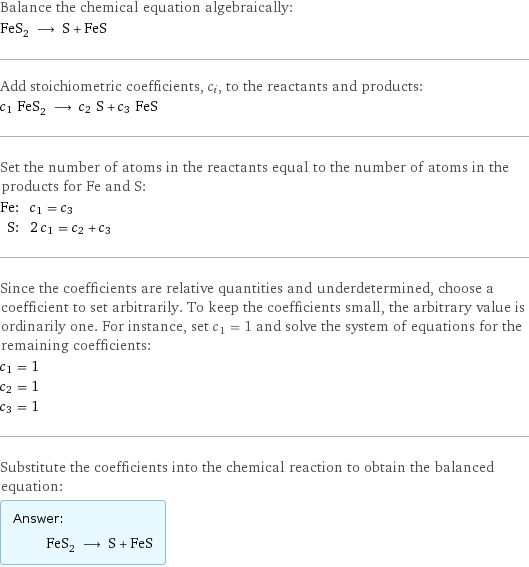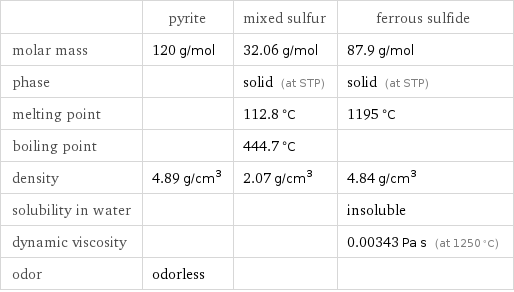Input interpretation

FeS_2 pyrite ⟶ S mixed sulfur + FeS ferrous sulfide
Balanced equation

Balance the chemical equation algebraically: FeS_2 ⟶ S + FeS Add stoichiometric coefficients, c_i, to the reactants and products: c_1 FeS_2 ⟶ c_2 S + c_3 FeS Set the number of atoms in the reactants equal to the number of atoms in the products for Fe and S: Fe: | c_1 = c_3 S: | 2 c_1 = c_2 + c_3 Since the coefficients are relative quantities and underdetermined, choose a coefficient to set arbitrarily. To keep the coefficients small, the arbitrary value is ordinarily one. For instance, set c_1 = 1 and solve the system of equations for the remaining coefficients: c_1 = 1 c_2 = 1 c_3 = 1 Substitute the coefficients into the chemical reaction to obtain the balanced equation: Answer: | | FeS_2 ⟶ S + FeS
Structures

⟶ +
Names

pyrite ⟶ mixed sulfur + ferrous sulfide
Equilibrium constant
![Construct the equilibrium constant, K, expression for: FeS_2 ⟶ S + FeS Plan: • Balance the chemical equation. • Determine the stoichiometric numbers. • Assemble the activity expression for each chemical species. • Use the activity expressions to build the equilibrium constant expression. Write the balanced chemical equation: FeS_2 ⟶ S + FeS Assign stoichiometric numbers, ν_i, using the stoichiometric coefficients, c_i, from the balanced chemical equation in the following manner: ν_i = -c_i for reactants and ν_i = c_i for products: chemical species | c_i | ν_i FeS_2 | 1 | -1 S | 1 | 1 FeS | 1 | 1 Assemble the activity expressions accounting for the state of matter and ν_i: chemical species | c_i | ν_i | activity expression FeS_2 | 1 | -1 | ([FeS2])^(-1) S | 1 | 1 | [S] FeS | 1 | 1 | [FeS] The equilibrium constant symbol in the concentration basis is: K_c Mulitply the activity expressions to arrive at the K_c expression: Answer: | | K_c = ([FeS2])^(-1) [S] [FeS] = ([S] [FeS])/([FeS2])](../image_source/6c350ca6ef17c13f5bd375583e6b15ef.png)
Construct the equilibrium constant, K, expression for: FeS_2 ⟶ S + FeS Plan: • Balance the chemical equation. • Determine the stoichiometric numbers. • Assemble the activity expression for each chemical species. • Use the activity expressions to build the equilibrium constant expression. Write the balanced chemical equation: FeS_2 ⟶ S + FeS Assign stoichiometric numbers, ν_i, using the stoichiometric coefficients, c_i, from the balanced chemical equation in the following manner: ν_i = -c_i for reactants and ν_i = c_i for products: chemical species | c_i | ν_i FeS_2 | 1 | -1 S | 1 | 1 FeS | 1 | 1 Assemble the activity expressions accounting for the state of matter and ν_i: chemical species | c_i | ν_i | activity expression FeS_2 | 1 | -1 | ([FeS2])^(-1) S | 1 | 1 | [S] FeS | 1 | 1 | [FeS] The equilibrium constant symbol in the concentration basis is: K_c Mulitply the activity expressions to arrive at the K_c expression: Answer: | | K_c = ([FeS2])^(-1) [S] [FeS] = ([S] [FeS])/([FeS2])
Rate of reaction
![Construct the rate of reaction expression for: FeS_2 ⟶ S + FeS Plan: • Balance the chemical equation. • Determine the stoichiometric numbers. • Assemble the rate term for each chemical species. • Write the rate of reaction expression. Write the balanced chemical equation: FeS_2 ⟶ S + FeS Assign stoichiometric numbers, ν_i, using the stoichiometric coefficients, c_i, from the balanced chemical equation in the following manner: ν_i = -c_i for reactants and ν_i = c_i for products: chemical species | c_i | ν_i FeS_2 | 1 | -1 S | 1 | 1 FeS | 1 | 1 The rate term for each chemical species, B_i, is 1/ν_i(Δ[B_i])/(Δt) where [B_i] is the amount concentration and t is time: chemical species | c_i | ν_i | rate term FeS_2 | 1 | -1 | -(Δ[FeS2])/(Δt) S | 1 | 1 | (Δ[S])/(Δt) FeS | 1 | 1 | (Δ[FeS])/(Δt) (for infinitesimal rate of change, replace Δ with d) Set the rate terms equal to each other to arrive at the rate expression: Answer: | | rate = -(Δ[FeS2])/(Δt) = (Δ[S])/(Δt) = (Δ[FeS])/(Δt) (assuming constant volume and no accumulation of intermediates or side products)](../image_source/c3b5a343f5b89cd73e4193d4802493e0.png)
Construct the rate of reaction expression for: FeS_2 ⟶ S + FeS Plan: • Balance the chemical equation. • Determine the stoichiometric numbers. • Assemble the rate term for each chemical species. • Write the rate of reaction expression. Write the balanced chemical equation: FeS_2 ⟶ S + FeS Assign stoichiometric numbers, ν_i, using the stoichiometric coefficients, c_i, from the balanced chemical equation in the following manner: ν_i = -c_i for reactants and ν_i = c_i for products: chemical species | c_i | ν_i FeS_2 | 1 | -1 S | 1 | 1 FeS | 1 | 1 The rate term for each chemical species, B_i, is 1/ν_i(Δ[B_i])/(Δt) where [B_i] is the amount concentration and t is time: chemical species | c_i | ν_i | rate term FeS_2 | 1 | -1 | -(Δ[FeS2])/(Δt) S | 1 | 1 | (Δ[S])/(Δt) FeS | 1 | 1 | (Δ[FeS])/(Δt) (for infinitesimal rate of change, replace Δ with d) Set the rate terms equal to each other to arrive at the rate expression: Answer: | | rate = -(Δ[FeS2])/(Δt) = (Δ[S])/(Δt) = (Δ[FeS])/(Δt) (assuming constant volume and no accumulation of intermediates or side products)
Chemical names and formulas

| pyrite | mixed sulfur | ferrous sulfide formula | FeS_2 | S | FeS name | pyrite | mixed sulfur | ferrous sulfide IUPAC name | bis(sulfanylidene)iron | sulfur |
Substance properties

| pyrite | mixed sulfur | ferrous sulfide molar mass | 120 g/mol | 32.06 g/mol | 87.9 g/mol phase | | solid (at STP) | solid (at STP) melting point | | 112.8 °C | 1195 °C boiling point | | 444.7 °C | density | 4.89 g/cm^3 | 2.07 g/cm^3 | 4.84 g/cm^3 solubility in water | | | insoluble dynamic viscosity | | | 0.00343 Pa s (at 1250 °C) odor | odorless | |
Units
